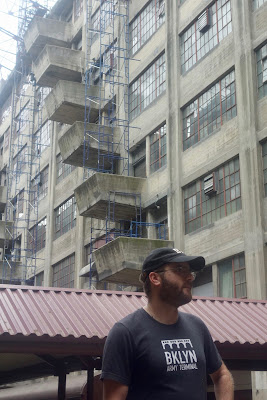Not that Cass Gilbert, the architect, wasn't capable of ornamentation. Look no further than Woolworth building for proof. Both structures display his fondness for symmetry.
Cranes positioned on a sliding red platform just under the once-glass roof lifted freight from the rail cars into staggered bays, constructed of poured concrete. Terminal operations must have been a sight to behold during the second World War.
The poured concrete and jutting edifices reminded me a little of Habitat 67 in Montreal.
Fun facts:
- Even though the Brooklyn Army Terminal was built in a matter of months, it wasn't completed until shortly after the first World War. That's bureaucracy for you!
- During Prohibition, the federal government used the mostly idle space to store contraband booze.
- Elvis Presley was one of the many Army draftees to pass through the terminal's doors shortly before its long decline. Shipping containers, which relied on easy access to highways for the trucking of goods, made it obsolete.
- New York City took out a $4 million dollar loan from the federal government to purchase the terminal for $8 million from the federal government not long after the city declared bankruptcy in 1975. That's bureaucracy for you!













No comments:
Post a Comment